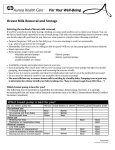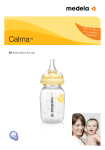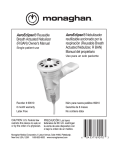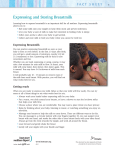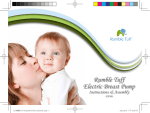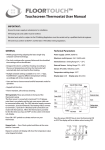Download Instructions for Use:
Transcript
Congratulations on your decision to give your baby the best possible start in life by breastfeeding. The multitude of health benefits for both you and your baby are well documented. Although breastmilk is always best, providing breastmilk for your baby when you have to be away isn’t always easy. It requires a special effort, and you should be very proud of your commitment to provide your baby the perfect nutrition for ideal growth and development. Our manual pump was designed to be quick and easy for mothers who have to pump occasionally and who appreciate the convenience of a manual pump. Instructions for Use: Please take five minutes to read though this manual before you use your Lansinoh Manual Breast Pump for the first time. Contents: 1 – Introducing the Lansinoh Manual Breast Pump 2 – Lansinoh Manual Breast Pump Parts 3 – How to Clean and Sterilise Your Lansinoh Manual Breast Pump 4 – How to Assemble Your Lansinoh Manual Breast Pump 5 – Tips About Pumping 6 – How to Use Your Lansinoh Manual Breast Pump 7 – How to Store Your Expressed Breast Milk 8 – Trouble Shooting for the Lansinoh Manual Breast Pump These instructions are also available for viewing on our website: www.lansinoh.co.uk 1 – Introducing the Lansinoh Manual Breast Pump: The Lansinoh Manual Breast Pump has been designed specifically with the needs of breastfeeding mothers in mind. Its ComfortSeal™ cushion creates a vacuum providing reliable suction while imitating your baby’s nursing rhythm resulting in comfortable and fast milk flow. The pump is easy to assemble, easy to use and easy to clean since all of the parts are dishwasher safe. For you and your baby’s safety, we have carefully chosen materials to avoid chemical substances contaminating your breastmilk. For this reason our bottle and flange are made of Polypropylene. The ComfortSeal™ cushion, diaphragm and valve are made of foodsafe silicone. The American Academy of Pediatrics and other major medical organisations recommend that babies be exclusively breastfed for 6 months, breastfed for 12 months with complementary foods and thereafter for as long as the mother and baby wish to continue. To assist you in meeting these goals, Lansinoh has created this Manual Breast Pump to help you provide breastmilk for your baby while you are separated, to help keep up your supply and to have your milk available for him or her when you are apart. 1 2 – Lansinoh Manual Breast Pump Parts: d c a b e f g a Flange cover / Bottle stand b ComfortSeal™ cushion c Silicone diaphragm and stem d Handle e Breast flange f White valve g Bottle cap with ring and sealing disk h Flange cleaning brush h Spare Parts: For your convenience, included with your pump is one (1) extra silicone diaphragm and stem and two (2) extra white valves. GB 2 3 – How to Clean and Sterilise Your Lansinoh Manual Breast Pump: Sterilise: Prior to using your pump for the first time, disassemble it (remove silicone diaphragm and stem, ComfortSeal™ cushion, white valve and separate bottle, cap and sealing disk) and boil all parts (including bottle stand/flange cover) for 10 minutes. Remove all parts from water immediately after boiling. Completely air dry before assembly and before the next use. Cleaning: The breast flange, bottles, handle and flange cover/bottle stand may be cleaned in the upper compartment of your dishwasher or hand washed with dish soap and hot water. For best results when hand washing the pump, we recommend using the cleaning brush to thoroughly clean your breast flange. Do not use solvents or abrasives. Rinse with hot, clean water. The white valve, silicone diaphragm and stem and the ComfortSeal™ cushion can be washed in the dishwasher; however, we recommend washing them by hand to prevent loss and to extend their usefulness. Completely air-dry all parts on a clean towel or drying rack. NOTE: Use caution when cleaning the small white valve. It is important for proper suction. Do not use excessive force and do not clean with a baby bottle brush, a nipple brush or the cleaning brush included with your pump. Gently wash by hand in hot soapy water and rinse under hot running water. 4 – How to Assemble Your Lansinoh Manual Breast Pump: Prior to assembling your Lansinoh Manual Breast Pump ensure that all parts have been cleaned and sterilised as detailed in section 3 of this manual. 1 - Wash your hands thoroughly. 2 - Gently secure the white valve onto the breast flange from underneath making sure the white valve is flush with the lip of the breast flange. It is not necessary to use excess force when applying the white valve. If you find that the white valve is difficult to remove, you have pushed it too far onto the breast flange. 3 3 - Screw the bottle onto the breast flange. 4 - Place the silicone diaphragm and stem on top of the breast flange. Make sure it fits securely around the rim by pressing down with your fingers to ensure a perfect seal. * 6 - Carefully insert the ComfortSeal™ cushion into the funnel of the breast flange making sure it is perfectly sealed around the rim of the funnel. * 7 - To make the pump completely stable, insert the bottle into the bottle stand. Or, when not in use, the bottle stand can be used as a cover over the breast flange (flange cover). 8 - When fully assembled, this is what your pump should look like. 5 - Place the forked end of the handle under the diaphragm stem and push down gently on the handle until it clicks into place. * These parts are designed to fit snugly. For easier assembly, just dampen the rim of the silicone diaphragm and/or ComfortSeal™ Cushion with water. GB 4 5 – Tips About Pumping: • Familiarise yourself with the pump and parts prior to use. • The most important part of successful pumping is the let-down reflex. This is when your milk begins to flow freely. Warm wet compresses applied to the breast and light, circular massaging of the breast prior to and/or during a pumping session can help this natural reflex occur. • Try to choose a time to pump when you are not rushed and will not be interrupted. Trying to relax while you are thinking of your baby or looking at a photo of your baby can also be helpful when pumping your milk. • Overall a pumping session can last about 20 – 30 minutes. Remember, successful pumping is a learned art. Early practice sessions may be shorter or longer than stated here and may result in only a small amount of milk collected. Milk is produced on a supply and demand basis and pumping your breasts regularly in addition to nursing your baby stimulates and maintains the milk supply. • If breastfeeding problems occur, call your physician, an International Board Certified Lactation Consultant, or breastfeeding advisor. • You may pump one breast while nursing the baby on the other. This allows you to maximise pumping effectiveness using the let down reflex stimulated by your baby’s suckling. • Make sure the tunnel of the breast flange is tilted slightly downward to allow the milk to flow naturally toward the bottle. • You may pump into any standard sized screw-top baby bottle. • Should you choose to use the Lansinoh bottle with a teat of your own, please take the following precautions: - Always test the temperature of any liquid before feeding your baby. - Do not let a child take a bottle to bed or self feed for long periods. - To prevent possible choking hazard, test strength of the teat by pulling on the bulb portion. Discontinue use if any tear or crack appears. 6 – How to Use Your Lansinoh Manual Breast Pump: If possible, wait until your milk supply and breastfeeding schedule are well established. This is normally at least 3-4 weeks after birth, unless told otherwise by your doctor or breastfeeding advisor. 1 - Wash your hands thoroughly and make sure your breasts are clean. 2 - Make sure you have sterilised and carefully assembled your pump exactly as 5 described in the sections “How to Clean and Sterilise Your Lansinoh Manual Breast Pump” and “How to Assemble Your Lansinoh Manual Breast Pump”. 3 - Press the breast flange and ComfortSeal™ cushion of the pump firmly against your breast; making sure the seal is secure so that no air can escape. 4 - As you gently push down on the pump handle you will feel the suction on your breast. You do not need to depress the handle fully to create a vacuum; only as much as is comfortable. Initially squeeze the handle with short quick compressions until let-down is achieved. Your milk will soon start flowing even though you may not use all the suction the pump can generate. 5 - Begin by pumping 6-7 times quickly to initiate let down. Then, hold the handle down for 2-3 seconds, and allow it to return to its resting place. These 2-3 second cycles imitate your baby’s natural nursing pattern and allow the milk to flow into the bottles between strokes. 6 - Milk should begin to flow after the first few strokes. Do not worry if your milk does not flow immediately. Relax and continue pumping. Warning: Do not continue pumping for more than five minutes at a time if no result is achieved. Try expressing at another time during the day. Please remember that, should pumping become very painful or uncomfortable, you should stop using the pump and consult your doctor or breastfeeding advisor. 7 – How to Store Your Expressed Breast Milk: Breast milk – best for your baby The milk you express for your baby is a precious fluid. It combines the best possible nutrition with antibodies, live cells, and other substances that protect babies from infection and help them grow and develop. You´ll want to take good care of it and how you store it will affect how well it is preserved. Storing and thawing your breastmilk. Breastmilk should be stored in a clean and sealed container. Lansinoh Milk Storage Bottles or Lansinoh Milk Storage Bags are ideal for collecting, storing and freezing your breastmilk. Please check website for availability (www.lansinoh.co.uk). If kept at room temperature (19 to 22ºC) it should be used within ten (10) hours. Use refrigerated (0º to 4ºC) breast milk within 72 hours; then freeze or discard. A refrigerator style freezer (temperatures vary), such as a side-by-side or top/bottom, can keep milk safely stored for three to six (3 to 6) months. In commercial deep freezers (-18ºC or less), milk can be safely stored for six (6) months or longer. DO NOT store your breast milk in freezer door. The door tends to be the warmest part of the freezer. Date all milk and use the oldest milk first. GB 6 Thawing Thaw frozen milk in the refrigerator or place the container under cool running water, gradually warming the water until the milk is thawed. Thawed milk can be kept in a refrigerator for up to 24 hours. DO NOT refreeze milk once it is thawed. Gently swirl the container of thawed milk before feeding to baby to mix the layers that have separated. Breast milk is not homogenised and the “cream” will rise to the top of the bottle. Breast milk can vary in color and consistency depending upon the time of the day that the milk was expressed, what you have eaten, and the age of the baby at the time of pumping. DO NOT shake the bottle vigorously to mix the layers as doing so can damage the live components of your milk. DO NOT MICROWAVE HUMAN MILK! Microwaving alters the composition of the milk. Microwaving also may create “hot spots” in the milk that could burn the infant. DO NOT thaw breast milk in very hot or boiling water. Source: La Leche League International 8 – Trouble Shooting for the Lansinoh Manual Breast Pump Lack of Suction / Decreased Suction If it feels like the suction has decreased, try the following: • Make sure that all pump parts have been properly assembled. • Inspect the white valve for a tear or pinhole. This component is critical to achieving proper suction. If necessary, replace the white valve with one of the spare valves provided with the pump. • Ensure that the silicone diaphragm and stem is fitted securely to the pump body and a perfect seal is created. • Ensure that the ComfortSeal™ cushion is fitted securely to the breast flange and a perfect seal is created. No Milk Expressed If you are not successful in expressing any milk, try the following: • Make sure that all the parts have been properly assembled and that proper suction is created. • Try to relax as successful pumping is a learned art and may take several practice attempts to get started. • Please refer to the “Tips About Pumping” section. 7 Pain When Pumping If you are experiencing pain when expressing milk, try the following: • You may be pumping too hard. It may not be necessary to use all of the suction that the pump can generate. Try depressing the handle half way and remember the 2-3 second suggested rhythm. • Consult your physician, breastfeeding advisor or lactation consultant. Lansinoh Breastmilk Storage Bottles Lansinoh Breastmilk Storage Bags GB 8











